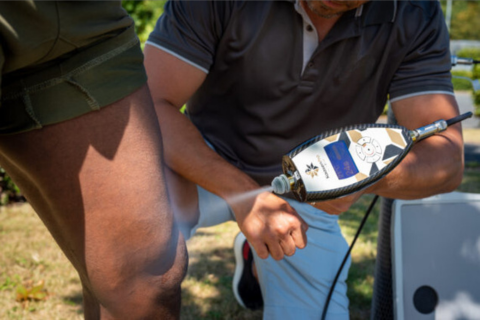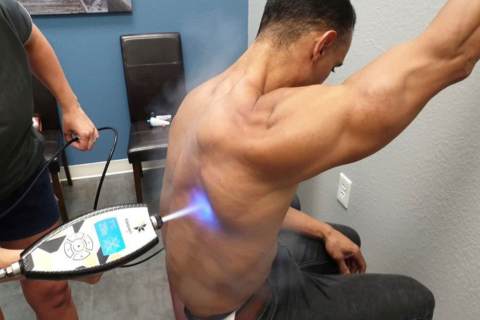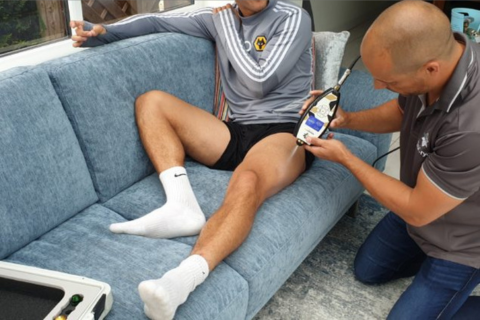LOCALIZED CRYOTHERAPY
Don't let chronic pain or lingering injuries hold you back any longer!

Experience the affects of hours of icing in only 8-10 mins with a LOCALIZED air stream of subzero temperatre to a specific area of the body. FASTER recovery time by DECREASING pain, inflammation and swelling.
One of the most popular reasons for using localized cryotherapy is to address bodily aches and pains. This is achieved through the stimulation of collagen production, which is the main structural protein found in skin and other connective tissues.
The promotion of collagen improves skin elasticity and is the primary protein the body uses to repair muscles, joints, tendons, and ligaments. The vaporized beam of liquid nitrogen that the treatment utilizes also promotes vasoconstriction, or the constriction of blood vessels, which furthers aids the healing process.
Device:
- Kaasen Pro by Tru°Cryo
Time duration:
- 10 mins
Benefits:
- Improved joint functionality.
- Treatment of muscle & ligament strains.
- Improved circulation.
- Increased resistance to fatigue.
- Relief from pain & inflammation.
- Decreased tension in muscles.
- Quicker recovery.
- Treatment of tendon injuries.
- Enhanced athletic performance.
- Prevent chronic fatigue.

Painless Procedure
When it comes to localized cryotherapy, unlike regular cold treatments such as ice packs, there is no moisture involved. Therefore, you won't experience any discomfort or pain during the treatment. With ice packs, you often feel numb and stiff until the treated area warms up. However, localized cryotherapy doesn't freeze the muscle tissues; it merely gives the perception of freezing. As a result, there will be no post-treatment pain or stiffness.
FAQ

What is Localized Cryotherapy (LC)?
Localized Cryotherapy (Pain Relief) is a cryostimulation treatment that increases blood flow to injured or sore muscles and joints. Extreme cold applied to the injured area stimulates oxygenated blood flow, reducing tension and inflammation.
Localized Cryotherapy (Pain Relief) with KaasenPro is achieved by stimulating thermal shock in the affected area by spraying a dry vapor of carbon dioxide (CO2) at -108oF/-78oC directly onto the skin of the affected area. The skin will be cooled to less than 39oF/4oC in around 30 seconds. The affected area will be exposed to 90-second streams of vapor using a freeze-thaw technique.
The treatments are powered by cryo-stimulation – a medical treatment used for immediate pain relief to help improve mobility and aid recovery by cooling tissues to within the temperature range of 41oF/5oC to 25oF/-4 ˚C. The cold treatment encourages the release of hormones, including noradrenaline and Beta-Endorphins, which are powerful natural painkillers. Cryo-stimulation also reduces systemic inflammation and muscle tension and stimulates an immediate improvement in blood flow and lymphatic drainage.
How is the LC session like?
Localized cryotherapy is a targeted form of cryotherapy that focuses on specific areas of the body rather than exposing the entire body to extreme cold temperatures.
There is no preparation needed for this service. You will sit comfortably while we apply to the desired area.
Here's a general overview of the process of localized cryotherapy:
1. Identification of Targeted Area:
- The first step involves identifying the specific area of the body that requires treatment. This could be a localized muscle group, joint, or other targeted region.
2. Application Method:
- We use our specialized device the Kassen Pro by Tru°Cryo, to apply cold therapy to a particular region.
3. Temperature Control:
- Our Kaasen Pro is designed to deliver controlled and adjustable temperatures to the specific area being treated.
- The temperature is typically very cold, but not as extreme as in whole body cryotherapy.
4. Duration of Treatment:
- Localized cryotherapy sessions are generally shorter than whole body cryotherapy sessions. The duration may range from a few minutes to around 15 minutes, depending on the device and the specific treatment goals.
5. Therapeutic Effects:
- The extreme cold induces vasoconstriction (narrowing of blood vessels) in the treated area, which can help reduce inflammation and swelling.
- After the treatment, there is often vasodilation (widening of blood vessels), promoting increased blood flow and oxygen to the area.
- These effects may contribute to pain relief, reduced swelling, and accelerated recovery in the targeted region.
6. Client Monitoring:
- A trained operator or healthcare professional may monitor the client throughout the session, ensuring the safety and effectiveness of the treatment.
7. Post-Treatment Activities:
- After the localized cryotherapy session, individuals may experience increased alertness and energy.
- Some people may engage in gentle movements or exercises to enhance the benefits of the treatment.
It's important to note that the specific features and operation of localized cryotherapy devices can vary. Individuals considering localized cryotherapy should consult with healthcare professionals to ensure its safety and appropriateness for their specific needs. As with any form of cryotherapy, it's crucial to follow the guidelines provided by the device manufacturer and healthcare practitioners to optimize the benefits and minimize potential risks.
What does LC assist with?
- Sciatica
- Joint Disfunction
- Sclerosis
- Arthritis
- Acute Muscle Spasms
- Plantar Fasciitis
- Sprains & Strains
- Tendonitis
- TMJ Disfunction
- Post Surgery Pain Control
- Head Injuries
How often should you do LC?
We recommend a localized treatment once a day, for 3-4 days in a row, for post injury or surgery and then as needed to maintain relief.
Who cannot do LC?
Localized Cryotherapy (Pain Relief) treatments are very safe for the vast majority of people. However, there are some contraindications, which means treatment should not be provided. Please answer the following questions honestly and advise the CRYO RELOAD employee if any of the following apply to you:
- Pregnant
- Cryoglobulinemia,
- Cold hemagululation or cold hemolysis
- Cold-induced itching
- Impaired arterial blood flow as from stage II
- Raynaud's Disease,
- Severe sensory disorders
- Trophic disorders
- Hypersensitivity to cold
